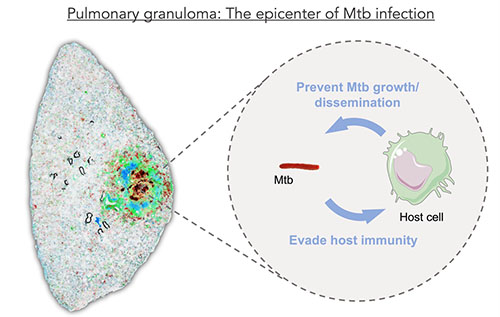Studying host-pathogen interactions as they occur in tissues
 Tuberculosis kills 1.5 million people annually and is a top 10 leading cause of death worldwide. Unfortunately, the limited efficacy of the only licensed tuberculosis vaccine (BCG) and the need for challenging, prolonged antibiotic treatment hamper our efforts to combat this deadly pandemic. To develop improved vaccines and treatments to combat tuberculosis, we need a better understanding of what is happening at the epicenter of infection: the pulmonary granuloma.
Tuberculosis kills 1.5 million people annually and is a top 10 leading cause of death worldwide. Unfortunately, the limited efficacy of the only licensed tuberculosis vaccine (BCG) and the need for challenging, prolonged antibiotic treatment hamper our efforts to combat this deadly pandemic. To develop improved vaccines and treatments to combat tuberculosis, we need a better understanding of what is happening at the epicenter of infection: the pulmonary granuloma.
To better understand the events within this epicenter of infection, the Gern Lab investigates host-pathogen interactions within the granuloma, with the ultimate goal of informing the design of improved treatments and vaccines. We utilize a combination of physiologic mouse models, human tissues, advanced immunologic tools, and cutting-edge quantitative imaging.
In so doing, we have uncovered a dominant factor (TGFβ) that limits immunity within the granuloma, gained insight into aspects of the early events of Mycobacterium tuberculosis (Mtb) infection, and characterized organizational features of tuberculous granulomas. We have also begun to characterize how different inflammatory responses lead to the wide range of pathologic structures that are a feature of tuberculosis disease. In the future, we have plans to test whether these processes are present in human granulomas and explore whether we can use treatments to shape these processes and improve infection outcomes.